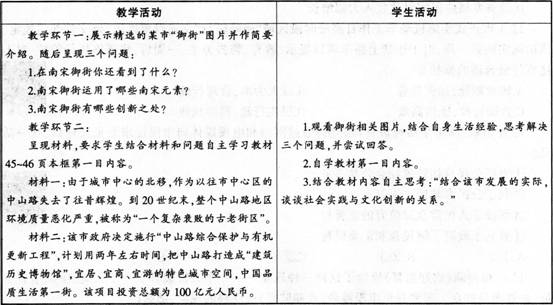当前位置:首页 → 职业资格 → 教师资格 → 中学英语学科知识与教学能力->设计任务:请阅读下面学生信息和语言素材,设计一节英语语言知识
设计任务:请阅读下面学生信息和语言素材,设计一节英语语言知识课的教学方案。教案没有固定格式,但必须包含下列要点:
●teaching objectives
●teaching contents
●key and difficult points
●major steps and time allocation
●activities and justifications
教学时间:45分钟
学生概况:某城镇普通中学八年级(初中二年级)学生,班级人数40人。多数已经达到《义务教育英语课程标准(2011年版)》三级水平。学生课堂参与积极性一般。
语言素材:

Teaching contents:The focus of this lesson is on learning the words and sentences related to diseases.
Teaching objectives:
(1)Knowledge objectives
Be able to master the pronunciation,meaning and spelling of the names of diseases:stomachache,sore back,fever,toothache;
Be able to learn the expressions of giving advice:lie down and rest,see a dentist,get an X-ray,take her temperature;
Be able to talk about health problems by using“What’s the matterI have a…”and give advice by using“You should…/You shouldn’t…”
(2)Ability objectives
Be able to talk about one’s health problems and give advice fluently;
Be able to role play doctor and patient.
(3)Emotion objectives
Improve the cooperative spirit through pair work and role playing
Care more about yourself and your family members’health.
Teaching key points:
(1)Master the names of diseases:stomachache,sore back,fever,toothache;
(2)Master the expressions of giving advice:lie down and rest,see a dentist,get an X-ray,take her temperature;
(3)Talk about health problems by using“What’s the matterI have a…”and give advice by using“You should…/You shouldn’t…”
Teaching difficult points:
(1)Students remember all the target new words in class:
(2)Students give appropriate advice to the certain disease because of their limited life experience.
Teaching procedures:
Step 1 Warming up(3 minutes)
Show a body image on the PPT.The teacher points to a body part,and students name it.Accordingly,the English spelling appears on the PPT next to the body part.
(Justification:The body image will help students review the words related to body.)
Step 2 Presentation and practice(17 minutes)
Task 1 Present the words
Show students a bandage and tell them there is something wrong in the place where the bandage lies.Then get students to guess the health problems.For example,when I put the bandage on the stomach,ask students:“What’s the matter with me”Help students say:“I'm not feeling well.I have a stomachache.”
Teach the other target words in the same way.
(Justification:The bondage will arouse students’curiosity and attract them to participate in the learning activity.Under the teacher's guidance,students learn the new words.)
Activity:Pair work
Put the bandage on the part of a student’s body and ask:“What’s the matter”and guide him to use the pattern:I’m not feeling well.I have a…Then ask students to work in pairs and talk about health problems by using the bandage given and using the target language:What’s the matterI'm not feeling well.I have a…
(Justification:Through pair work,students consolidate the new words and also perceive the target sentence.)
Task 2 Presentation of expressions of giving advice
Activity 1 Qs and As
Tell students that“I have a cold/cough”,ask them:What should I doStudents may give different answers,collect their answers and help them to use:You should/shouldn’t do…
Then show some pictures of other diseases mentioned before and ask them to give advice to each problem by using target language:You should/shouldn’t do…
During this activity,some phrases will be learned.
(Justification:Trough Qs and As the teacher presents and concludes the phrases into“You should/shouldn’t do…”)
Activity 2 Pair work
Show students two bags.In one bag,there are pieces of paper with problems while in the other one,there are pieces of paper with advice.Have a competition between boys and girls.Take turns to get paper.
For example,one boy get some paper with problem,and one girl gets one paper with advice.The girl should say:What's the matter with youThe boy should answer the question according to the problem he got by saying:I’m not feeling well.I have a…If the girl got the right advice,she should answer it according to her paper:You should…If it is not,she should say:You shouldn’t,then given the right advice.The one who makes right sentence can get one point.
(Justification:Students use the sentence to finish the pair work.)
Step 3 Production(20 minutes)
Activity 1 Making a conversation
The teacher sets a situation that a patient sees a doctor.Students imagine what conversation will take place between the doctor and the patient.They are given 5 minutes to discuss in groups.another 5 minutes to write a conversation.During students’discussion,the teacher should walk around the classroom and encourage students to use more sentences they have learned by recalling what conversation happened when they saw a doctor in real life.For example:
A:What’s the matter with you
B:rm not feeling well.I have a__________.
A:When did it start
B:About__________ago.
A:Oh,that's too bad./I'm sorry to hear that.You should/shouldn’t__________and you should/shouldn't__________.
B:Yes,I think so.
A:__________.
B:Thank you,doctor.
(Justification:Imaging and making a conversation between the doctor and the patient makes the class activity closely related to the real life.)
Activity 2 Role playing
Ask students to make a four-people group,one of them is a doctor,the other three are patients.Ask the students to role play the dialogue above.Then ask several groups to perform by using some tools:bandage,a uniform,a stethoscope.Other students should act as a judge to select the best doctor and the best patient.
(Justification:This activity further applies the target knowledge to real life.Through role play,students can develop their speaking and listening skills.This is also a visual way to assess students’mastery of the knowledge.)
Step 4 Summary and homework(5 minutes)
Students and teacher summarize what they have learned together.Students write the summary in their note book.
Homework:(1)Recite the new words and phrases.
(2)Give advice to parents/friends in English if they don’t feel well.
(Justification:The summary and homework can consolidate the knowledge learned in class.)
Board plan:

阅读下列材料内容,根据课程标准要求,写出教学内容的教学难点及理由(9分),并设计突破这一难题的教学策略。(17分)
世界上一切事物都包含着既相互对立.又相互统一的两个方面。矛盾就是反映事物内部对立统一关系的哲学范畴。简言之,矛盾就是对立统一。矛盾的对立属性是斗争性,矛盾的统一属性是同一性。它们是矛盾所固有的相反相成的两种基本属性。
矛盾的统一性,是矛盾双方相互吸引,相互联结的属性和趋势,它有两方面的含义:一是矛盾双方相互依赖,一方的存在以另一方的存在为前提,双方共处于一个统一体中;二是矛盾双方相互贯通,即相互渗透,相互包含,在一定条件下相互转化。
矛盾的斗争性,是矛盾双方相互排斥、相互对立的属性。它体现着对立双方相互分离的倾向和趋势。
同一性以差别和对立为前提。没有斗争性,就没有矛盾双方的相互依存和相互贯通,事物就不能存在和发展。斗争性寓于同一性之中,并为同一性所制约,没有同一性,就没有矛盾统一体的存在,事物同样不能存在和发展。矛盾双方既对立又统一,由此推动了事物的运动、变化和发展。
——摘自人民教育出版社普通高中课程标准实验教科书《思想政治必修4——生活与哲学》“矛盾的同一性和斗争性”。
下面是某校高二年级一道学业水平考试的模拟试题及答案要点。
人类离不开海洋,离不开资源丰富的家园,随着人们对海洋资源的肆意开发和狂捕滥捞,近海渔业资源急剧衰竭。浙江象山21名渔老大通过电子邮件和漂流瓶,向联合国和21个滨海国家元首呼吁每年在鱼类产卵和繁殖的高峰季节禁止捕鱼,并向世界渔民发出“蓝色保护志愿者”行动倡议。渔老大的呼吁和倡议,折射出政治、经济、哲学等多方面问题。结合上述材料,以“从渔老大的呼吁看……”为题,分别从《经济生活》《政治生活》《生活与哲学》的角度拟一个课题.并说明理由。
【答案要点】
(1)从渔老大的呼吁看国家宏观调控的必要性。市场调节具有自发性、盲目性和滞后性特点。在近海渔业资源急剧衰竭的背景下,需要国家规定相应的禁渔期以增加渔业资源的发展量。
(2)从渔老大的呼吁看,国家必须增加社会主义法制建设。国家应制定渔业生产法规,以规范渔民与捕捞行为。
(3)从渔老大的呼吁看,必须正确处理尊重客观规律和发挥主观能动性的关系。如果在鱼类产卵和繁殖高峰期捕鱼,势必影响今后的渔业生产。(其他答案,可根据是否与题目具有相关性以及所运用知识的合理性酌情给分)
问题:请根据新课程倡导的评价理念对上述试题及答案作简要评述。(20分)
阅读材料,并回答问题。
材料一:
下列是《文化生活》中“文化创新的源泉和作用”这一教学内容的教学实录片段:

问题:结合该市发展的实际,谈谈社会实践与文化创新的关系。(20分)
传统的思想政治课教学中,教师更注重学生的学习成绩,而忽视对学生情感、态度、价值观的培养。
问题:运用新课程理念,就如何解决这一问题谈谈你的看法。(12分)
材料一:

材料二:
科学发展观的核心是以人为本。要始终把实现好、维护好、发展好最广大人民的根本利益作为党和国家一切工作的出发点和落脚点。科学发展观的基本要求是全面协调可持续,要按照中国特色社会主义事业总体布局,全面推进经济、政治、文化、社会建设。科学发展观的根本方法是统筹兼顾,要统筹城乡发展、区域发展、人与自然和谐发展。
问题:结合上述材料说明我国政府是怎样通过财政支出进一步落实科学发展观的。(12分)
人是法律关系的主体。法律要求尊重每个人的人格和尊严。下面属于民法中人身权的是( )。
①用益物权②名誉权③隐私权④生命健康权
我国合同法规定的承担的合同违约责任方式是( )。
①继续履行②支付违约金③赔偿损失④返还财产
法律是维持社会秩序、调整社会关系的一种行为规范,法律的主要内容( )。
中华文化博大精深,处处闪烁着辩证法思想的光辉。“千里之行,始于足下”“推陈出新,革故鼎新”“因地制宜.因材施教”“金无足赤.人无完人”所蕴含的哲学道理依次是( )。
①矛盾具有特殊性,要具体问题具体分析
②辩证的否定是“扬弃”,是事物发展的环节
③量变是质变的必要准备,质变是量变的必然结果④事物的性质是由主要矛盾的主要方面决定的,看问题要一分为二
求真务实不可能一蹴而就。一劳永逸。彼时的“真”不能代替此时的“真”,彼时的“实”不能代替此时的“实”。这段话强调了( )。